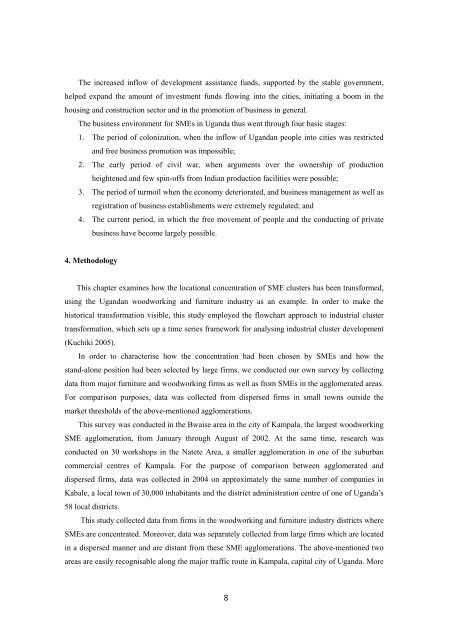Information - ARRIDE - IDE-JETRO
Information - ARRIDE - IDE-JETRO
Information - ARRIDE - IDE-JETRO
Create successful ePaper yourself
Turn your PDF publications into a flip-book with our unique Google optimized e-Paper software.
The increased inflow of development assistance funds, supported by the stable government,<br />
helped expand the amount of investment funds flowing into the cities, initiating a boom in the<br />
housing and construction sector and in the promotion of business in general.<br />
The business environment for SMEs in Uganda thus went through four basic stages:<br />
1. The period of colonization, when the inflow of Ugandan people into cities was restricted<br />
and free business promotion was impossible;<br />
2. The early period of civil war, when arguments over the ownership of production<br />
heightened and few spin-offs from Indian production facilities were possible;<br />
3. The period of turmoil when the economy deteriorated, and business management as well as<br />
registration of business establishments were extremely regulated; and<br />
4. The current period, in which the free movement of people and the conducting of private<br />
business have become largely possible.<br />
4. Methodology<br />
This chapter examines how the locational concentration of SME clusters has been transformed,<br />
using the Ugandan woodworking and furniture industry as an example. In order to make the<br />
historical transformation visible, this study employed the flowchart approach to industrial cluster<br />
transformation, which sets up a time series framework for analysing industrial cluster development<br />
(Kuchiki 2005).<br />
In order to characterise how the concentration had been chosen by SMEs and how the<br />
stand-alone position had been selected by large firms, we conducted our own survey by collecting<br />
data from major furniture and woodworking firms as well as from SMEs in the agglomerated areas.<br />
For comparison purposes, data was collected from dispersed firms in small towns outside the<br />
market thresholds of the above-mentioned agglomerations.<br />
This survey was conducted in the Bwaise area in the city of Kampala, the largest woodworking<br />
SME agglomeration, from January through August of 2002. At the same time, research was<br />
conducted on 30 workshops in the Natete Area, a smaller agglomeration in one of the suburban<br />
commercial centres of Kampala. For the purpose of comparison between agglomerated and<br />
dispersed firms, data was collected in 2004 on approximately the same number of companies in<br />
Kabale, a local town of 30,000 inhabitants and the district administration centre of one of Uganda’s<br />
58 local districts.<br />
This study collected data from firms in the woodworking and furniture industry districts where<br />
SMEs are concentrated. Moreover, data was separately collected from large firms which are located<br />
in a dispersed manner and are distant from these SME agglomerations. The above-mentioned two<br />
areas are easily recognisable along the major traffic route in Kampala, capital city of Uganda. More<br />
8




![Title [書評] 廣田義人著『東アジア工作機械工業の技術形成 ... - ARRIDE](https://img.yumpu.com/47139953/1/184x260/title-arride.jpg?quality=85)






